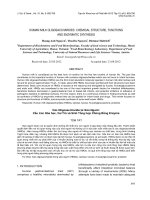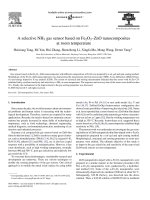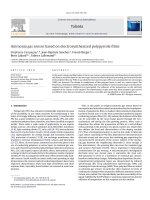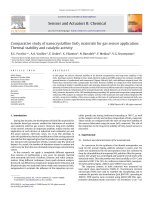- Trang chủ >>
- Khoa Học Tự Nhiên >>
- Vật lý
crystalline structure, defects and gas sensor response
Bạn đang xem bản rút gọn của tài liệu. Xem và tải ngay bản đầy đủ của tài liệu tại đây (393.75 KB, 11 trang )
Crystalline structure, defects and gas sensor response to
NO
2
and H
2
S of tungsten trioxide nanopowders
I. Jime
´
nez
*
, J. Arbiol, G. Dezanneau, A. Cornet, J.R. Morante
Departament d’Electro
`
nica, Enginyeria i Materials Electro
`
nics, Universitat de Barcelona, Barcelona 08028, Spain
Abstract
Structural and NO
2
and H
2
S gas-sensing properties of nanocrystalline WO
3
powders are analysed in this work. Sensor response of thick-
film gas sensors was studied in dry and humid air. Interesting differences were found on the sensor response between sensors based on 400 and
700 8C-annealed WO
3
, what motivated a structural study of these materials. Crystalline structure and defects were characterised by X-ray
diffraction (XRD), Raman spectroscopy and transmission electron microscopy (TEM). Experimental results showed that both triclinic and
monoclinic structures are present in the analysed materials, although their amount depends on the annealing treatment. Crystalline shear
planes, which are defects associated to oxygen deficient tungsten trioxide, were found in 400 8C-annealed WO
3
and their influence on XRD
spectra was analysed by XRD simulations. Moreover, XRD and Raman spectra were also acquired at normal metal oxide-based gas sensor
working temperatures in order to relate both crystalline structure and sensor response.
# 2003 Elsevier Science B.V. All rights reserved.
Keywords: WO
3
; Gas sensor; Structural characterisation; NO
2
;H
2
S
1. Introduction
Tungsten oxide is nowadays considered as one of the most
interesting materials in the field of gas sensors based on
metal oxides, as it is shown by the increasing number of
publications appeared in recent years. Very good results in
the detection of NO
2
and H
2
S by sensors based on this
material have been reported. Most of them concern WO
3
thin films obtained by physical routes such as sputtering
[1,2] or thermal evaporation [3,4]. Besides, thick-films
technologies based on the use of nanopowders have been
also presented [5,6]. Powder is mixed with an organic
vehicle to form a paste, which is usually deposited on a
substrate as a thick sensitive film, although compatibility
with micromachined gas sensors is also possible [7–10].
Since gas sensors based on metal oxides must usually work
at temperatures ranging from 200 to 400 8C, the sensing
material has to be previously stabilised at higher tempera-
tures. This annealing step will strongly affect the structural
properties of the nanocrystalline material and thus its gas-
sensing properties too.
Regarding WO
3
, the pyrolysis of ammonium paratung-
state has been one of the most used routes to obtain this
material as powder with nanometric grain size, being a well-
known technique in the field of gas sensors [11,12]. In the
same way, dehydration of tungstic acid has revealed as an
interesting route to obtain WO
3
with low impurities con-
centration [13,14], although it is not so usual in the field of
gas sensors. Gas sensors based on WO
3
obtained by this
route showed a better sensor response to NO
2
than that of
pyrolytic WO
3
-based gas sensors under the same test con-
ditions, combined with a low response to CO and CH
4
[15].
The aim of this work is to study the evolution of structural
properties of WO
3
nanocrystalline powders as a function of
annealing temperature in order to understand the sensor
response to NO
2
and H
2
S of gas sensors based on differently
annealed WO
3
. Thick-film gas sensors based on differently
annealed WO
3
nanopowders (400 and 700 8C) were pre-
pared and their gas-sensing properties towards NO
2
and H
2
S
in dry and humid air were compared. The differences found
in gas-sensing motivated a study of the crystalline properties
and their evolution with annealing temperature. The com-
bination of characterisation techniques such as X-ray dif-
fraction (XRD), Raman spectroscopy and transmission
electron microscopy (TEM) allows to precise the structure
of the synthesised compounds and the nature of possible
defects. Furthermore, XRD and Raman spectra were also
acquired at normal working sensor temperatures for the
detection of our target gases (between room temperature
and 300 8C) in order to better relate structural and gas-
sensing properties.
Sensors and Actuators B 93 (2003) 475–485
*
Corresponding author. Tel.: þ34-934-021-146; fax: þ34-934-021-148.
E-mail address: (I. Jime
´
nez).
0925-4005/03/$ – see front matter # 2003 Elsevier Science B.V. All rights reserved.
doi:10.1016/S0925-4005(03)00198-9
2. Experimental
WO
3
nanocrystalline powders were obtained by a soft
chemistry route based on tungstic acid. Tungstic acid was
dissolved in a 50:50 volumic mixture of methanol and water
with a tungsten over water molar ratio of 25. This solution
was heated at 80 8C for 24 h under stirring in air and dried by
further heating at 110 8C in air, leading to tungsten oxide
hydrate. This material was annealed in a furnace between
400 and 700 8C for 5 h under a flow of synthetic air to obtain
nanocrystalline WO
3
.
Gas sensors were obtained by screen-printing of a paste
based on WO
3
over alumina substrates, which had already
printed platinum electrodes on the front side and a platinum
heater on the backside to control the operating temperature.
These gas sensor devices were placed in a stainless steel test
chamber (200 ml) where a controlled atmosphere was pro-
vided by means of mass flow controllers connected to a
computer. The sensor response was acquired for different
concentrations of H
2
S and NO
2
in synthetic dry and humid
air at a flow of 200 ml min
À1
. Humidity was controlled by
mixing the appropriate quantities of dry air with water-
bubbling air, monitoring the relative humidity with a com-
mercial capacitive humidity sensor. Gas sensor response was
calculated as the resistance ratio R
gas
/R
air
for both gases.
Operating temperature of the sensor devices was varied
between 200 and 300 8C. Sensor response at lower tempera-
tures was not studied in order to avoid too high sensor
resistance, which may lead to not reliable sensor response
measurements.
XRD patterns of the nanopowders were obtained with a
Siemens D-500 X-ray diffractometer using Cu Ka radiation,
with operating voltage of 40 kV and current of 30 mA.
Raman scattering measurements were obtained in back-
scattering geometry with a Jobin-Yvon T64000 spectro-
meter coupled to an Olympus metallographic microscope.
Excitation was provided by an argon-ion laser operating at a
wavelength of 488.0 nm with a low incident power to avoid
thermal effects. Raman shifts were corrected by using
silicon reference spectra after each measurement. Trans-
mission electron microscopy was carried out on a Phillips
CM30 SuperTwin electron microscope operated at
300 keV with 0.19 nm point resolution. For TEM observa-
tions, WO
3
nanopowders were ultrasonically dispersed
in ethanol and deposited on amorphous holey carbon
membranes.
3. Results and discussion
3.1. Gas sensor response
Fig. 1a shows sensor response to 1 ppm of NO
2
and
20 ppm of H
2
S in synthetic dry air of gas sensors based
on 400 and 700 8C-annealed WO
3
as a function of sensor
working temperature. In the range of working temperatures
studied, from 200 to 300 8C, sensor response increased when
temperature decreased for both gases. A similar behaviour
has already been described for NO
2
and H
2
S detection by
WO
3
[3,6], although their sensing mechanisms are comple-
tely different. The detection of NO
2
is usually based on the
formation of absorbed surface-trap states NO
À
2
ads, whereas
H
2
S molecules react with surface oxygen. In our case, it was
found that WO
3
annealed at 700 8C had a higher sensor
response to both gases than 400 8C-annealed WO
3
in this
operation temperature range.
Sensor response to NO
2
and H
2
S in wet air was analysed
at fixed operation temperatures (200 8C for H
2
S and 225 8C
for NO
2
detection). These temperatures were selected so as
to achieve a compromise between sensor response and
recovery time, which decrease when operating temperature
increases in the case of NO
2
detection. Fig. 1b shows the
Fig. 1. (a) Sensor response to H
2
S and NO
2
of gas sensors based on 400 and 700 8C-annealed WO
3
as functions of working temperature, (b) Sensor response
to H
2
S (200 8C) and NO
2
(225 8C) of gas sensors based on 400 and 700 8C-annealed WO
3
as functions of relative humidity.
476 I. Jime
´
nez et al. / Sensors and Actuators B 93 (2003) 475–485
dependence of the sensor response to NO
2
and H
2
Son
humidity for 400 and 700 8C-annealed WO
3
, whereas
Fig. 2a and b show a comparison of the dynamic sensor
responses to these gases in dry and humidified air (50% of
relative humidity). This sensor response was evaluated
taking sensor resistance in dry or humidified synthetic air
as the reference. Response and recovery times, for both
gases, have a low dependence on humidity, as sensor
response to NO
2
. On the other hand, sensor response to
H
2
S is highly dependent on humidity, especially for 700 8C-
annealed WO
3
. In fact, only sensor resistance in H
2
S atmo-
sphere is highly dependent on humidity, as it will be shown
later. According to sensor response and humidity depen-
dency, 400 8C-annealed WO
3
was chosen for further H
2
S
detection studies, whereas 700 8C-annealed WO
3
was cho-
sen for NO
2
detection. Sensor responses of this materials
to different concentrations of H
2
S(1–10 ppm) and NO
2
(0.2–2 ppm) under different humidified ambiences are
shown in Fig. 3, which still clearly shows a greater influence
of humidity on H
2
S detection than on NO
2
detection.
Finally, in order to study this great influence of humidity
on H
2
S sensor response, pulses of humidity (1 h) were
introduced in atmospheres of synthetic air and H
2
S
(2 ppm) in synthetic air, keeping the concentration of this
gas constant. Fig. 4 shows the results for the gas sensor based
on 400 8C-annealed WO
3
. This experimental procedure, the
study of the dynamical response of metal oxide gas sensors
to pulses of humidity in atmospheres containing a target gas,
Fig. 2. Dynamic sensor response of WO
3
-based gas sensors to (a) 1ppm of NO
2
in dry and 50% relative humidity air, (b) 5 ppm of H
2
S in dry and 50%
relative humidity air.
Fig. 3. Sensor response to different concentrations of NO
2
(400 8C-annealed WO
3
) and H
2
S (700 8C-annealed).
I. Jime
´
nez et al. / Sensors and Actuators B 93 (2003) 475–485 477
has revealed as a very useful method to investigate the
interaction of not only water, but also that of the target
gas with the sensing material [16]. When humidified air was
introduced in a background of synthetic air, resistance
decreased very fast and afterwards increased slowly, reach-
ing a final value very close to the resistance value in dry
synthetic air. Similar dynamic responses have been already
described for SnO
2
,In
2
O
3
and ZnO [17], although the reason
is not completely understood yet. The decrease in sensor
resistance was attributed to the dissociatively reaction of
water with lattice oxygen, which leads to the formation of
oxygen vacancies and so to a resistance decrease. The
following slow resistance increase could be due to the
recombination of the OH
À
ions with the lattice oxygen
vacancies previously formed. As it is shown in our case,
humidity has a low effect on base resistance in synthetic air
in the case of these WO
3
-based gas sensors. However, it is
interesting to notice that this behaviour is completely dif-
ferent when the background is H
2
S in air. In this case, there
is no fast decay of resistance but an important increase when
humidity is introduced, which shows that water is probably
competing with H
2
S molecules and preventing some oxygen
ions from reacting with H
2
S. When dry air is reintroduced
again, previous sensor resistance value is recovered,
although response time is slower, probably due to a slow
desorption of adsorbed water. Similar dynamic results were
found for 700 8C-annealed WO
3
, although a greater influ-
ence of humidity on resistance in the presence of H
2
S was
found. Therefore, this may show not only that water is
competing with H
2
S, but also that there are more than
one reactive oxygen species participating on the detection
of this gas, since 400 and 700 8C-annealed WO
3
are differ-
ently affected. Therefore, the reactive site blocked by water
would be much more abundant in 700 8C-annealed than in
400 8C-annealed WO
3
.
3.2. Structural characterisation
Annealed powder was identified by XRD as nanocrystal-
line WO
3
. Crystalline WO
3
presents a pseudo-cubic struc-
ture with a slight distortion of the cubic ReO
3
-type lattice,
where W atoms occupy the centre of oxygen octahedra
linked by their corners. At room temperature, monoclinic
and triclinic are the most common structures [18]. Mono-
clinic is described in the P21/n space with cell parameters
a ¼ 0:7301 nm, b ¼ 0:7539 nm, c ¼ 0:7689 nm and b ¼
90:89
. The triclinic structure is described in the P-1 space
group with cell parameters a ¼ 0:7310 nm, b ¼ 0:7524 nm,
c ¼ 0:7686 nm, a ¼ 88:85
, b ¼ 90:91
, g ¼ 90:935
. Fig. 5
presents XRD patterns from 2y ¼ 20 to 408 of WO
3
samples
annealed at different temperatures (400, 500, 600 and
700 8C). This figure also includes theoretical diffraction
diagrams of the triclinic and monoclinic compounds. These
diagrams have been calculated using the program FULL-
PROF [19], taking the cell parameters and atomic positions
of [18] and an artificial crystallite size of 50 nm. Due to the
slight distortion of the lattice, the main reflection (1 0 0) of
the ideal cubic cell splits in three in the range 20–308 [20];
(1 0 0), (0 1 0) and (0 0 1) pseudo-cubic reflections.
Although these reflections are referred as (2 0 0), (0 2 0)
and (0 0 2) if the monoclinic or triclinic unit cells are con-
sidered, indexations will be referred herein to the pseudo-
cubic representation with cell parameter a % 0:38 nm. It is
clear from Fig. 5 these three main reflections can not be used
to determine if the crystalline structure is triclinic or mono-
clinic, since their position and relative intensity is very
Fig. 4. Sensor resistance variation (400 8C-annealed WO
3
) to pulses of humidity (30, 50 and 80% relative humidity) in a background of synthetic air and H
2
S
(2 ppm) in synthetic air.
478 I. Jime
´
nez et al. / Sensors and Actuators B 93 (2003) 475–485
similar for both structures when dealing with nanometric
grain sizes. However, it is interesting to notice the evolution
of the full width at half maximum (FWHM) and maximum
intensity with annealing temperature of these three main
peaks, shown in Fig. 6. Whereas relative intensities of the
three main reflections should be almost identical, experi-
mental spectra show that diffraction peak corresponding to
(0 0 1) reflection (at 23.128) is broader and not so well
defined as the other two for low annealing temperatures.
This is reflected by the evolution of FWHM of (0 0 1)
reflection in Fig. 6, as it only approaches the values of
the other two peaks after a 700 8C annealing. A similar
behaviour is presented by the maximum peak intensity as a
function of annealing temperature. Since these character-
istics should be similar for these three reflections, either in
the case of monoclinic or triclinic hypothesis, the nature of
this difference should be attributed to the presence of some
bulk defects that would mainly affect the (0 0 1) reflection
peak. This fact will be further discussed according to TEM,
selected area electron diffraction (SAED) observations and
XRD simulations.
Regarding crystalline structure identification by XRD, the
distribution of diffraction peak intensities in the range 32–
358 has been used in literature to distinguish between
Fig. 5. XRD spectra of obtained WO
3
(annealed at indicated temperature). Triclinic and monoclinic simulated spectra are also shown.
Fig. 6. Evolution of FWHM and intensity of the three main XRD reflections with annealing temperature.
I. Jime
´
nez et al. / Sensors and Actuators B 93 (2003) 475–485 479
triclinic and monoclinic structures [21], as simulations of
triclinic and monoclinic structures suggest in Fig. 5. In our
case, intensities agree better with the hypothesis of a mono-
clinic structure. Nevertheless, due to the small mean crystal-
lite size, between 30 and 70 nm [15],reflections are badly
resolved and the possibility of a mixture of both monoclinic
and triclinic phases should be considered, as Raman inves-
tigations will show. As regards TEM investigations, diffuse
ring patterns obtained by selected area electron diffraction
(SAED) (not shown) were not sufficient to determine the
amount of triclinic/monoclinic crystalline structure of the
samples either.
On the other hand, a detailed analysis performed by high-
resolution electron microscopy (HRTEM) showed some
wide fringes next to the borders of some of the 400 8 C-
annealed WO
3
nanoparticles, as it is marked with black
arrows in Fig. 7. Detailed SAED pattern showed large
reflections corresponding to typical WO
3
and short reflec-
tions that have been assigned to Magneli phases (SAED
pattern inset in Fig. 7). These phases correspond to oxygen
deficient tungsten trioxide with formulas W
n
O
3nÀ2
[22].
Since these wide fringes were superposed to the WO
3
atomic
planes, a detailed digital image analysis was carried out in
order to separate these phases and study them. Firstly, a
representative squared area from Fig. 7 was selected (Fig. 8a)
and a FFT image of this squared region was obtained
(Fig. 8b). Afterwards, spots corresponding to the WO
3
planes and to the Magneli Phase on the FFT were selected
and filtered by using a mask filter, in order to obtain their
representation in separate images, as shown in Fig. 8c and d.
From these images, it can be concluded that the wide planes
observed correspond to shear planes, in good agreement
with those {1 0 3}
R
crystallographic shear (CS) defects
observed by Sloan et al. [23], where {1 0 3}
R
refer to the
family of equivalent directions expressed in the ideal ReO
3
cubic cell. Visible between the CS planes, 0.38 nm lattice
fringes corresponding to the (0 1 0) WO
3
planes were found.
In tungsten trioxide, it is possible to shear the structure in
such a way that oxygen vacancies are eliminated and some
tungsten atoms remain more closely spaced, so pairs of W
5þ
atoms are found in order to compensate the charge left by the
oxygen deficiency. These phases, called Magneli phases,
correspond to oxygen deficient tungsten trioxide. All of
them present a crystalline structure based on WO
3
zones
(corner sharing WO
6
octahedra) linked by units of edge
sharing octahedra in the CS phases [23]. These bulk defects
influence the electrical transport properties: carrier concen-
tration increases, as each missing oxygen atom contributes
two carriers, and carrier mobility decreases [24]. This kind
of defect was not found by HRTEM in samples annealed at
temperatures over 400 8C.
Although these substoichiometric regions seemed to be
very localised, as diffraction patterns generally observed
were those of typical stoichiometric WO
3
, it is reasonable to
think that some shear planes could be also present inside the
bulk material. These planes may affect the intensities of
XRD reflections and this effect has been studied by XRD
simulations with the software Diffax [25]. Two kinds of
layers were defined: the first one corresponds to an unfaulted
WO
3
derived structure (cell no. 1), whereas the other one
(cell no. 2) corresponds to the planar defect. Both cells are
represented in Fig. 9a, where vectors defining the unit cell 1,
2 and cubic unit cell are also shown. In this representation,
W atoms occupy the centre of oxygen octahedra. For the
sake of simplicity, the atomic positions have been first
described in a cubic representation, the unit cells being
Fig. 7. HRTEM micrograph from a 400 8C-annealed WO
3
nanoparticle. The inset corresponds to the SAED pattern of this nanoparticle. Wide fringes have
been marked with black arrows. The squared region has been digitally analyzed in Fig. 4.
480 I. Jime
´
nez et al. / Sensors and Actuators B 93 (2003) 475–485
artificially distorted at the end (orthorhombic unit cells) to
reflect the distortion of WO
3
structure. The cells parameters
used for the pseudo-cubic unit cell were a
0
¼ 0:365 nm,
b
0
¼ 0:377 nm, c
0
¼ 0:384 nm and the shear plane direction
was [0 1 3], according to HRTEM investigations. Simula-
tions have been performed supposing a random stacking of
layer 1 and layer 2 with a given probability associated to
each layer. On Fig. 9b, simulations for different probabilities
of shear planes are shown. It can be seen that for a zero
percent probability for layer 2, i.e. a stacking of unfaulted
WO
3
layers, the distribution of intensities for the three main
diffraction peaks remain similar to that observed for mono-
clinic or triclinic structures, confirming the validity of the
approximation done on atomic positions. When the prob-
ability of layer 2 presence increase, the intensities of calcu-
lated (0 0 1) reflection diminishes while its width increases.
A similar tendency is observed for the (0 1 0) reflection but
to a lower extent. These results agree with the evolution of
Fig. 8. (a) Magnified detail of the squared region in Fig. 7, (b) FFT of image 4.a, (c) 0.38 nm WO
3
lattice fringes corresponding to the {1 0 0}
R
planes
obtained after selecting the large reflections in 4.b, (d) {1 0 3}
R
crystallographic shear (CS) defects from Magneli phases obtained after selecting the short
reflections in 4.b.
Fig. 9. (a) Representation of the layers used for XRD simulation: the first one corresponds to an unfaulted WO
3
derived structure (cell no. 1), whereas the
other one (cell no. 2) corresponds to the planar defect, (b) XRD simulations considering different probabilities of shear planes.
I. Jime
´
nez et al. / Sensors and Actuators B 93 (2003) 475–485 481
experimental XRD diffraction patterns of samples annealed
between 400 and 700 8C(Fig. 5), confirming that the TEM
observed CS planes could be responsible for the anomalous
XRD pattern of the (0 0 1) reflection after a 400 8C-anneal-
ing. Therefore, this anomalous reflection behaviour can be
used as an indirect proof of the presence of bulk oxygen
deficiencies. Higher annealing temperatures would reduce
the presence of these defects, according to experimental a
simulated XRD patterns and TEM observations.
Regarding Raman spectroscopy, it is able to give a clearer
evidence of the monoclinic or triclinic nature of the WO
3
phase, since the lowest frequency phonon modes are dif-
ferent for both structures. Cazzanelli et al. [21] reported that
monoclinic structure presents a peak at 34 cm
À1
, while
triclinic presents a peak at 43 cm
À1
. Fig. 10 shows that only
the peak corresponding to triclinic phase was present in
powders annealed at 4008. When annealing temperature is
increased, the peak at 34 cm
À1
appears and both peaks seem
to coexist in the range of annealing temperatures studied.
Similar results concerning the evidence of triclinic-mono-
clinic coexistence in WO
3
by Raman have also been
reported by Souza-Filho et al. [26]. Therefore, powders
annealed at 400 8C have mainly a triclinic phase and both
monoclinic and triclinic phases coexist at higher annealing
temperatures.
Finally, XRD and Raman spectra of 400 and 700 8C-
annealed powders were also acquired under controlled
temperature (from room temperature to 300 8C for both
techniques) and ambient conditions (synthetic dry air only
for Raman spectra). The aim of this study was to determine if
the previously shown structural differences could also be
present at normal sensor operating temperatures. Concern-
ing XRD (not shown), displacements lower than 0.18 respect
room temperature were found and they were attributed to
thermal effects. However, apart from these displacements,
no appreciable changes on spectra were found. Therefore,
taking into account the previous results, this would mean
that CS defects are also present at normal sensor working
temperatures in 400 8C-annealed WO
3
. Regarding Raman
spectra, no trace of the 34 cm
À1
monoclinic vibration was
found on the 400 8C-annealed sample in the range of
temperatures studied (Fig. 11a). This fact is remarkable,
since transition temperature between triclinic and monocli-
nic temperature is set around 20 8C [18]. In the case of
700 8C-annealed WO
3
(Fig. 11b), 34 cm
À1
monoclinic
vibration became broader and collapsed over 100 8C with
the peak at 43 cm
À1
, typical of triclinic structure. Therefore,
this would lead to think that 400 8C-annealed WO
3
is able to
maintain its triclinic structure at least up to 100 8C. Over this
temperature, unfortunately, it is not possible to determine the
predominant crystalline structure since 700 8C-annealed
WO
3
showed only a single broad peak over 100 8C. Similar
situations have been already described for WO
3
, such as a
tetragonal metastable phase at room temperature [27], while
it is considered to appear over 1000 8K.
Basically, Raman spectroscopy showed that both triclinic
and monoclinic structures are present in WO
3
nanocrystal-
line powder obtained from tungstic acid. Their abundance
depends on annealing temperature and seems to be stable at
least up to 100 8 C. TEM showed the presence of CS planes,
associated to oxygen deficiencies, in 400 8C-annealed WO
3
,
whereas they were not observed in materials annealed at
higher temperatures. XRD simulations based on the pre-
sence of this defect showed that it might be responsible for
the anomalous XRD pattern of the 0 0 1 reflection, confirm-
ing its disappearance with annealing over 400 8C. However,
Fig. 10. Low-frequency Raman spectra of obtained WO
3
(annealed at indicated temperature).
482 I. Jime
´
nez et al. / Sensors and Actuators B 93 (2003) 475–485
no change of the 400 8C-annealed WO
3
XRD pattern was
observed when XRD measuring temperature was changed
between room temperature and 300 8C. As a result, this
defect may be present at usual working sensor temperatures.
3.3. Discussion
In addition to an obvious difference of mean grain size
and crystalline quality between materials annealed at 400
and 700 8C [15], previously reported structural differences
have to be taken into account to explain differences on
sensor response. Some influences of structural properties on
sensor response to NO
2
and H
2
S have been already discussed
in literature. For instance, it has been reported that high
annealing temperature leads to better NO
2
sensor response,
despite grain size increase, in screen-printed gas sensors
based on SnO
2
nanopowders [28]. This was attributed to the
improvement of the crystalline quality and the faceting of
nanograins, which improved NO
2
adsorption. Additionally,
sensor response of WO
3
to H
2
S has been reported to be
highly dependent on crystalline structure, with especially
good results in the case of tetragonal structure [23], although
there is no reference about influence of triclinic or mono-
clinic structure influence, to the best of our knowledge.
Fig. 11. (a) evolution of the low-frequency Raman spectra of 400 8C-annealed WO
3
with measurement temperature, (b) evolution of the low-frequency
Raman spectra of 700 8C-annealed WO
3
with measurement temperature.
I. Jime
´
nez et al. / Sensors and Actuators B 93 (2003) 475–485 483
Finally, influence of crystalline shear planes and bulk oxy-
gen deficiencies on electrical conduction (carrier concentra-
tion and mobility) has also been reported [23]. In our case, as
these defects disappear when annealing temperature
increases over 400 8C, oxygen deficiencies may drift to
the surface of the grain and become reactive sites for the
adsorption of NO
2
and oxygen molecules [29,30], the latter
being consumed by H
2
S, and this may thus improve sensor
response. It is well known that the formation of chemical
bonds between gaseous species and metal oxides depends on
the presence of unsaturated bonds on the surface of the
material, so the amount of chemisorbed species increases
with surface defect concentration [31]. As revealed by the
introduction of humidity pulses in the presence of H
2
S, it is
clear that water is competing with H
2
S on the grain surface
and some sites are blocked for H
2
S reaction. Since gas
sensors based on 700 8C-annealed is much more affected,
this may lead to think these sites are more abundant in
700 8C-annealed WO
3
, provided there is more than one
reactive site. Nevertheless, more spectroscopic in situ mea-
surements are in progress in order to confirm these hypoth-
eses, which may explain reported differences on sensor
response.
4. Conclusions
Crystalline structure, defects and gas sensor response to
NO
2
and H
2
S of nanocrystalline WO
3
were analysed in this
work. Annealing temperature was varied between 400 and
700 8C. Gas sensors based on 700 8C-annealed tungsten
trioxide showed a better response to NO
2
and H
2
S in dry
air than the ones based on 400 8C-annealed WO
3
.Influence
of humidity on the detection of these gases was also ana-
lysed. Gas sensors based on 700 8C-annealed tungsten tri-
oxide exhibited a lower influence of humidity on NO
2
response, whereas gas sensors based on 400 8C-annealed
WO
3
showed a lower influence of humidity on H
2
S detec-
tion. Regarding structural characterisation, two crystalline
structures (triclinic and monoclinic) in WO
3
nanocrystalline
powders obtained from tungstic acid were identified by
Raman spectroscopy. The abundance of these structures
was dependent on annealing temperature. Crystalline shear
planes defects, related to oxygen deficiencies, were present
in 400 8C-annealed WO
3
, as revealed by TEM investiga-
tions. Comparison between XRD simulations and experi-
mental data showed that the amount of these defects in bulk
is decreasing when annealing temperature increases from
400 to 700 8C. This fact may mean that oxygen deficiencies
are displaced to the outermost part of the grain, increasing
thus reactive sites. These structural characteristics were also
studied at normal sensor working temperatures by Raman
and XRD. It was found that triclinic structure was stable, at
least, up to 100 in 400 8C-annealed WO
3
. Besides, crystal-
line shear plane defects were present at operating tempera-
tures under 300 8C, according to XRD results.
References
[1] G. Sberveglieri, L. Depero, S. Groppelli, P. Nelli, WO
3
sputtered
thin films for NO
x
monitoring, Sens. Actuators, B 26–27 (1995)
89–92.
[2] S. Moulzolf, S. Ding, R. Lad, Stoichiometry and microstructure
effects on tungsten oxide chemiresistive films, Sens. Actuators, B 77
(2001) 375–382.
[3] C. Cantalini, H.T. Sun, M. Faccio, M. Pelino, S. Santucci, L. Lozzi,
M. Passacantando, NO
2
sensitivity of WO
3
thin film obtained by high
vacuum thermal evaporation, Sens. Actuators, B 31 (1996) 81–87.
[4] D. Lee, J. Lim, S. Lee, J. Huh, D. Lee, Fabrication and
characterization of micro-gas sensor for nitrogen oxides gas
detection, Sens. Actuators, B 64 (2000) 31–36.
[5] H. Lin, C. Hsu, H. Yang, P. Lee, C. Yang, Nanocrystalline WO
3
-
based H
2
S sensors, Sens. Actuators, B 22 (1994) 63–68.
[6] J. Solis, S. Saukko, L. Kish, C. Granqvist, V. Lantto, Semiconductor
gas sensors based on nanostructured tungsten oxide, Thin Solid Films
391 (2001) 255–260.
[7] D. Vincenzi, A. Butturi, V. Guidi, M. Carotta, G. Martinelli, V.
Guarnieri, S. Brida, B. Margesin, F. Giaocemozzi, M. Zen, D. Giusti,
G. Soncini, A. Vaisiliev, A. Pisliakov, Gas-sensing device imple-
mented on a micromachined membrane: a combination of thick-film
and very large scale integrated technologies, J. Vac. Sci. Technol., B
18 (2000) 2441–2445.
[8] I. Simon, N. Barsan, M. Bauer, U. Weimar, Micormachined metal
oxide gas sensors: opportunities to improve sensor performance,
Sens. Actuators, B 73 (2001) 1–26.
[9] J. Cerda, A. Cirera, A. Vila, A. Cornet, J.R. Morante, Deposition on
micromachined silicon substrates of gas sensitive layers obtained by
a wet chemical route: a CO/CH
4
high performance sensor, Thin Solid
Films 391 (2001) 265–269.
[10] I. Jime
´
nez, A. Cirera, A. Cornet, J.R. Morante, Pulverisation method
for active layer coating on microsystems, Sens. and Actuators, B 84
(2002) 78–82.
[11] M. Akiyama, J. Tamaki, N. Miura, N. Yamazoe, Tungsten oxide-
based semiconductor sensor highly sensitive to NO and NO
2
, Chem.
Lett. (1991) 1611–1614.
[12] J. Tamaki, Z. Zhang, K. Fujimori, M. Akiyama, T. Harada, N. Miura,
N. Yamazoe, Grain-size effects in tungsten oxide-based sensor for
nitrogen oxides, J. Electrochem. Soc. 141 (1994) 2207–2210.
[13] J.H. Kim, K.L. Kim, A study of preparation of tungsten nitride
catalysts with high surface area, Appl. Catal. A 181 (1999) 103–111.
[14] C. Bala
´
zsi, M. Farkas-Jahnke, I. Kotsis, L. Petra
´
s, J. Pfeifer, The
observation of cubic tungsten trioxide at high-temperature dehydra-
tion of tungstic acid hydrate, Solid State Ionics 141-142 (2001)
411–416.
[15] I. Jime
´
nez, J. Arbiol, A. Cornet, J.R. Morante, Structural and gas-
sensing properties of WO
3
nanocrystalline powders obtained by a
sol-gel method from tungstic acid, IEEE Sens. J. 2 (4) (2002) 329–
335.
[16] R. Ionescu, A. Vancu, C. Moise, A. Tomescu, Role of water vapour
in the interaction of SnO
2
gas sensors with CO and CH
4
, Sens.
Actuators, B 61 (1999) 39–42.
[17] T. Kuse, S. Takahashi, transitional behavior of tin oxide semicon-
ductor under a step-like humidity change, Sens. Actuators, B 67
(2000) 36–42.
[18] P. Woodward, A. Sleight, T. Vogt, Structure refinement of
triclinic tungsten trioxide, J. Phys. Chem. Solids 56 (1995) 1035–
1315.
[19] J. Rodriguez-Carvajal, FULLPROF: a program for Rietveld refine-
ment and pattern matching analysis, Abstracts of the Satellite
Meeting on Powder Diffraction of the XV Congress of the IUCr,
Toulouse, France, 1990, p. 127.
[20] L.E. Depero, S. Groppelli, I. Natali-Sora, L. Sangaletti, G.
Sberveglieri, E. Tondello, Structural studies of tungsten-titanium
oxide thin films, Solid State Chem. 121 (1996) 379–387.
484 I. Jime
´
nez et al. / Sensors and Actuators B 93 (2003) 475–485
[21] E. Cazzanelli, C. Vinegoni, G. Mariotto, A. Kuzmin, J. Purans, Low-
temperature polymorphism in tungsten trioxide powders and its
dependence on mechanical treatments, J. Solid State Chem. 143
(1999) 24–32.
[22] K. Kosuge, Chemistry of non-stoichiometric compounds, Oxford
University Press, Oxford, 1994, p. 120.
[23] J. Sloan, J. Hutchison, R. Tenne, Y. Feldman, T. Tsirlina, M. Homyonfer,
Defect and ordered tungsten oxides encapsuled inside 2H-WX
2
fullerene-related structures, J. Solid State Chem. 144 (1999) 100–117.
[24] J.G. Allpress, R.J.D. Tilley, M.J. Sienko, Examination of sub-
stoichiometric WO
3Àx
crystals by electron microscopy, J. Solid State
Chem. 3 (1971) 440–451.
[25] M.M.J. Treacy, J.M. Newsam, M.W. Deem, A general recursion
method for calculating diffracted intensities from crystals containing
planar faults, Proc. Roy. Soc. Lond. A 433 (1991) 499–520.
[26] A. Souza-Filho, V. Freire, J. Sasaki, J. Mendes-Filho, J. Juliao, U.
Gomes, Coexistence of triclinic and monoclinic phases in WO
3
ceramics, J. Raman Spect. 31 (2000) 451–454.
[27] J. Solis, S. Saukko, L. Kish, C. Granqvist, V. Lantto, Nanocrystalline
tungsten oxide thick-films with high sensitivity to H
2
S at room
temperature, Sens. Actuators, B 77 (2001) 316–321.
[28] A. Die
´
guez, A. Romano-Rodrı
´
guez, J.L. Alay, J.R. Morante, N.
Ba
ˆ
rsan, J. Kappler, U. Weimar, W. Go
¨
pel, Parameter optimisation in
SnO2 gas sensors for NO2 detection with low cross-sensitivity to CO:
sol-gel preparation, film preparation, powder calcination, doping and
grinding, Sens. Actuators, B 65 (2000) 166–168.
[29] S.R. Aliwell, J.F. Halsall, K.F.E. Pratt, J. O’Sullivan, R.L. Jones,
R.A. Cox, S.R. Utembe, G.M. Hansford, D.E. Williams, Ozone
sensors based on WO
3
: a model for sensor drift and a measurement
correction method, Meas. Sci. Technol. 12 (2001) 684–690.
[30] M. Ivanovskaya, A. Gurlo, P. Bogdanov, Mechanism of O
3
and NO
2
detection and selectivity of In
2
O
3
sensors, Sens. Actuators, B 77
(2001) 264–267.
[31] V.E. Henrich, P.A. Cox, The surface Science of Metal Oxides,
Cambridge University Press, Cambridge, 1994, p. 257.
I. Jime
´
nez et al. / Sensors and Actuators B 93 (2003) 475–485 485









